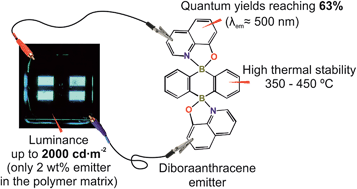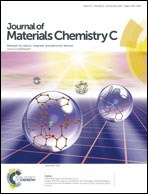Efficient 8-oxyquinolinato emitters based on a 9,10-dihydro-9,10-diboraanthracene scaffold for applications in optoelectronic devices†
Abstract
A detailed experimental characterization and theoretical evaluation of the optical as well as other relevant physicochemical properties of a series of 9,10-dihydro-9,10-diboraanthracene bis(8-oxyquinolinates) and a few other related systems is reported. The obtained compounds exhibit green luminescence with quantum yields of emission of up to 63% in CH2Cl2. Single crystal X-ray diffraction studies indicate that 9,10-dihydro-9,10-diboraanthracene complexes exist either as bent conformers (stabilized by a weak intramolecular CH⋯O interaction bringing two 8-oxyquinolinato ligands closer to each other) or symmetrical ones (bearing two ligands related by a centre of symmetry and separated from each other). Theoretical calculations revealed that the LUMO levels are lower for the bent conformers than for the symmetrical ones. This suggests that the luminescent properties of the studied compounds are affected by their specific structural properties. The obtained compounds were used as emitters for the construction of organic light emitting diodes (OLEDs). The highest luminance of ca. 2000 cd m−2 was recorded for the device containing only 2.0 wt% of the 1,6-difluoro-9,10-dihydro-9,10-diboraanthracene core in the poly(N-vinylcarbazole/2-t-butylphenyl-5-biphenyl-1,3,4-oxadiazole (PVK:PBD) matrix. The fabricated OLEDs exhibit current efficiency in the range from 0.5 to 1.1 cd A−1.


 Please wait while we load your content...
Please wait while we load your content...